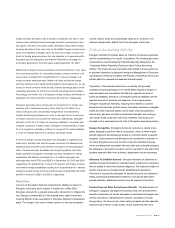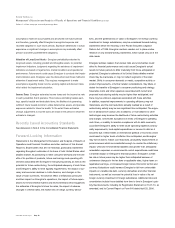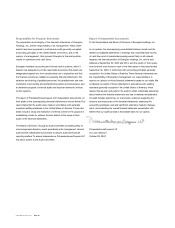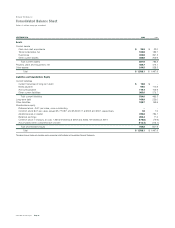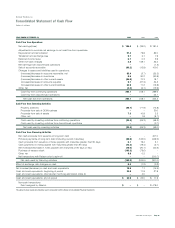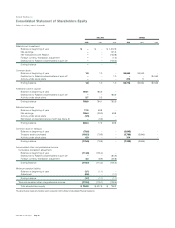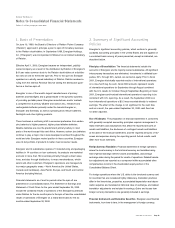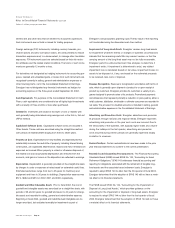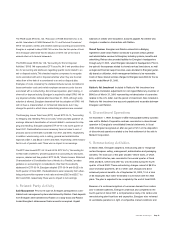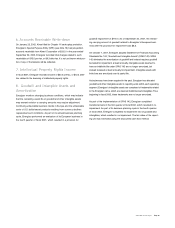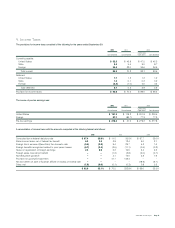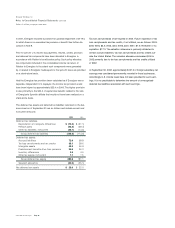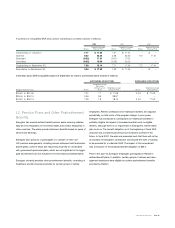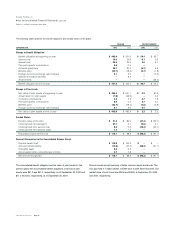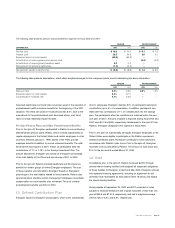Energizer 2002 Annual Report Download - page 29
Download and view the complete annual report
Please find page 29 of the 2002 Energizer annual report below. You can navigate through the pages in the report by either clicking on the pages listed below, or by using the keyword search tool below to find specific information within the annual report.
The FASB issued SFAS No. 145, “Rescission of FASB Statements No. 4, 44,
and 64, Amendment of FASB Statement No. 13, and Technical Corrections.”
SFAS 145 updates, clarifies and simplifies existing accounting pronouncements.
Energizer is required to adopt SFAS 145 no later than the first quarter of fiscal
2003. Energizer determined that the adoption of SFAS 145 will not have a
material effect on its financial statements.
The FASB issued SFAS No. 146, “Accounting for Exit or Disposal
Activities.” SFAS 146 supercedes EITF Issue No. 94-3 and provides direc-
tion for accounting and disclosure regarding specific costs related to an
exit or disposal activity. This standard requires companies to recognize
costs associated with exit or disposal activities when they are incurred
rather than at the date of a commitment to an exit or disposal plan.
Examples of costs covered by the standard include, but are not limited to
lease termination costs and certain employee severance costs that are
associated with a restructuring, discontinued operation, plant closing, or
other exit or disposal activity. Energizer is required to adopt SFAS 146 for
any disposal activities initiated after December 31, 2002, although early
adoption is allowed. Energizer determined that the adoption of SFAS 146
will not have a material effect on its financial statements, but it may
change the period in which future restructuring provisions are recorded.
The Emerging Issues Task Force (EITF) issued EITF 00-10, “Accounting
for Shipping and Handling Fees and Costs,” which provides guidance on
earnings statement classification of amounts billed to customers for ship-
ping and handling. Energizer adopted EITF 00-10 in its fourth quarter of
fiscal 2001. Reclassifications were necessary from net sales to cost of
products sold and were $34.4 and $36.1 for 2001 and 2000, respectively.
In addition, warehousing costs in selling, general and administrative
expense of $31.1 and $33.2 in 2001 and 2000, respectively, were reclassi-
fied to cost of products sold. There was no impact to net earnings.
The EITF also issued EITF 00-14 and 00-25. EITF 00-14, “Accounting for
Certain Sales Incentives,” provides guidance on accounting for discounts,
coupons, rebates and free product. EITF 00-25, “Vendor Income Statement
Characterization of Consideration from a Vendor to a Retailer,” provides
guidance on accounting for considerations other than those directly
addressed in EITF 00-14. Energizer adopted EITF 00-14 and 00-25 in its
fourth quarter of fiscal 2001. Reclassifications were necessary from adver-
tising and promotion expense to net sales and were $28.3 and $22.7 for
2001 and 2000, respectively. There was no impact to net earnings.
3. Related Party Activity
Cash Management Prior to the spin-off, Energizer participated in a cen-
tralized cash management system administered by Ralston. Cash deposits
from Energizer were transferred to Ralston on a daily basis and Ralston
funded Energizer’s disbursement bank accounts as required. Unpaid
balances of checks were included in accounts payable. No interest was
charged or credited on transactions with Ralston.
Shared Services Energizer and Ralston entered into a Bridging
Agreement under which Ralston continued to provide certain general
and administrative services to Energizer, including systems, benefits and
advertising. Ralston also provided facilities for Energizer’s headquarters
through July 31, 2001, when Energizer relocated its headquarters. Prior to
the spin-off, the expenses related to shared services listed above, as well
as legal and financial support services, were allocated to Energizer gener-
ally based on utilization, which management believes to be reasonable.
Costs of these shared services charged to Energizer were $9.6 for the six
months ended March 31, 2000.
Ralston’s Net Investment Included in Ralston’s Net Investment are
cumulative translation adjustments for non-hyperinflationary countries of
$84.6 as of March 31, 2000 representing net devaluation of currencies
relative to the U.S. dollar over the period of investment. Also included in
Ralston’s Net Investment are accounts payable and receivable between
Energizer and Ralston.
4. Discontinued Operations
On November 1, 1999, Energizer’s OEM rechargeable battery business
was sold to Moltech Corporation and was recorded as a discontinued
operation in Energizer’s consolidated financial statements. In fiscal
2000, Energizer recognized an after-tax gain of $1.2 on the disposition
of discontinued operations related to the final settlement of the sale to
Moltech Corporation.
5. Restructuring Activities
In March 2002, Energizer adopted a restructuring plan to reorganize
certain European selling, management, administrative and packaging
activities. The total cost of this plan was $6.7 before taxes, of which
$4.5, or $2.9 after-tax, was recorded in the second quarter of fiscal
2002 and $2.2, before and after-tax, was recorded during the fourth
quarter of fiscal 2002. These restructuring charges consist of $5.2 for
cash severance payments, $1.0 of other cash charges and $.5 in
enhanced pension benefits. As of September 30, 2002, 10 of a total
of 64 employees have been terminated in connection with the 2002
plans. The plan is expected to be complete by the end of fiscal 2003.
Because of a continued migration of consumer demand from carbon
zinc to alkaline batteries, Energizer undertook and completed in the
fourth quarter of fiscal 2001 a comprehensive study of its carbon zinc
manufacturing plant locations and capacities. Energizer also reviewed
its worldwide operations in light of competitive market conditions and
ENR 2002 Annual Report Page 27


